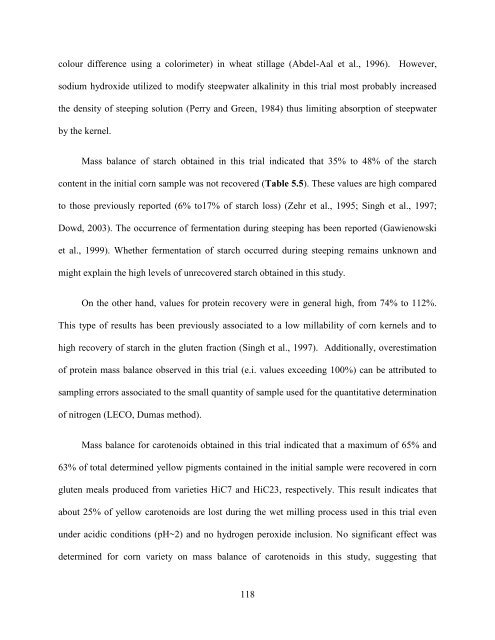Pigment Reduction in Corn Gluten Meal and Its Effects on Muscle ...
Pigment Reduction in Corn Gluten Meal and Its Effects on Muscle ...
Pigment Reduction in Corn Gluten Meal and Its Effects on Muscle ...
Create successful ePaper yourself
Turn your PDF publications into a flip-book with our unique Google optimized e-Paper software.
colour difference us<str<strong>on</strong>g>in</str<strong>on</strong>g>g a colorimeter) <str<strong>on</strong>g>in</str<strong>on</strong>g> wheat stillage (Abdel-Aal et al., 1996). However,sodium hydroxide utilized to modify steepwater alkal<str<strong>on</strong>g>in</str<strong>on</strong>g>ity <str<strong>on</strong>g>in</str<strong>on</strong>g> this trial most probably <str<strong>on</strong>g>in</str<strong>on</strong>g>creasedthe density of steep<str<strong>on</strong>g>in</str<strong>on</strong>g>g soluti<strong>on</strong> (Perry <str<strong>on</strong>g>and</str<strong>on</strong>g> Green, 1984) thus limit<str<strong>on</strong>g>in</str<strong>on</strong>g>g absorpti<strong>on</strong> of steepwaterby the kernel.Mass balance of starch obta<str<strong>on</strong>g>in</str<strong>on</strong>g>ed <str<strong>on</strong>g>in</str<strong>on</strong>g> this trial <str<strong>on</strong>g>in</str<strong>on</strong>g>dicated that 35% to 48% of the starchc<strong>on</strong>tent <str<strong>on</strong>g>in</str<strong>on</strong>g> the <str<strong>on</strong>g>in</str<strong>on</strong>g>itial corn sample was not recovered (Table 5.5). These values are high comparedto those previously reported (6% to17% of starch loss) (Zehr et al., 1995; S<str<strong>on</strong>g>in</str<strong>on</strong>g>gh et al., 1997;Dowd, 2003). The occurrence of fermentati<strong>on</strong> dur<str<strong>on</strong>g>in</str<strong>on</strong>g>g steep<str<strong>on</strong>g>in</str<strong>on</strong>g>g has been reported (Gawienowskiet al., 1999). Whether fermentati<strong>on</strong> of starch occurred dur<str<strong>on</strong>g>in</str<strong>on</strong>g>g steep<str<strong>on</strong>g>in</str<strong>on</strong>g>g rema<str<strong>on</strong>g>in</str<strong>on</strong>g>s unknown <str<strong>on</strong>g>and</str<strong>on</strong>g>might expla<str<strong>on</strong>g>in</str<strong>on</strong>g> the high levels of unrecovered starch obta<str<strong>on</strong>g>in</str<strong>on</strong>g>ed <str<strong>on</strong>g>in</str<strong>on</strong>g> this study.On the other h<str<strong>on</strong>g>and</str<strong>on</strong>g>, values for prote<str<strong>on</strong>g>in</str<strong>on</strong>g> recovery were <str<strong>on</strong>g>in</str<strong>on</strong>g> general high, from 74% to 112%.This type of results has been previously associated to a low millability of corn kernels <str<strong>on</strong>g>and</str<strong>on</strong>g> tohigh recovery of starch <str<strong>on</strong>g>in</str<strong>on</strong>g> the gluten fracti<strong>on</strong> (S<str<strong>on</strong>g>in</str<strong>on</strong>g>gh et al., 1997). Additi<strong>on</strong>ally, overestimati<strong>on</strong>of prote<str<strong>on</strong>g>in</str<strong>on</strong>g> mass balance observed <str<strong>on</strong>g>in</str<strong>on</strong>g> this trial (e.i. values exceed<str<strong>on</strong>g>in</str<strong>on</strong>g>g 100%) can be attributed tosampl<str<strong>on</strong>g>in</str<strong>on</strong>g>g errors associated to the small quantity of sample used for the quantitative determ<str<strong>on</strong>g>in</str<strong>on</strong>g>ati<strong>on</strong>of nitrogen (LECO, Dumas method).Mass balance for carotenoids obta<str<strong>on</strong>g>in</str<strong>on</strong>g>ed <str<strong>on</strong>g>in</str<strong>on</strong>g> this trial <str<strong>on</strong>g>in</str<strong>on</strong>g>dicated that a maximum of 65% <str<strong>on</strong>g>and</str<strong>on</strong>g>63% of total determ<str<strong>on</strong>g>in</str<strong>on</strong>g>ed yellow pigments c<strong>on</strong>ta<str<strong>on</strong>g>in</str<strong>on</strong>g>ed <str<strong>on</strong>g>in</str<strong>on</strong>g> the <str<strong>on</strong>g>in</str<strong>on</strong>g>itial sample were recovered <str<strong>on</strong>g>in</str<strong>on</strong>g> corngluten meals produced from varieties HiC7 <str<strong>on</strong>g>and</str<strong>on</strong>g> HiC23, respectively. This result <str<strong>on</strong>g>in</str<strong>on</strong>g>dicates thatabout 25% of yellow carotenoids are lost dur<str<strong>on</strong>g>in</str<strong>on</strong>g>g the wet mill<str<strong>on</strong>g>in</str<strong>on</strong>g>g process used <str<strong>on</strong>g>in</str<strong>on</strong>g> this trial evenunder acidic c<strong>on</strong>diti<strong>on</strong>s (pH~2) <str<strong>on</strong>g>and</str<strong>on</strong>g> no hydrogen peroxide <str<strong>on</strong>g>in</str<strong>on</strong>g>clusi<strong>on</strong>. No significant effect wasdeterm<str<strong>on</strong>g>in</str<strong>on</strong>g>ed for corn variety <strong>on</strong> mass balance of carotenoids <str<strong>on</strong>g>in</str<strong>on</strong>g> this study, suggest<str<strong>on</strong>g>in</str<strong>on</strong>g>g that118
















